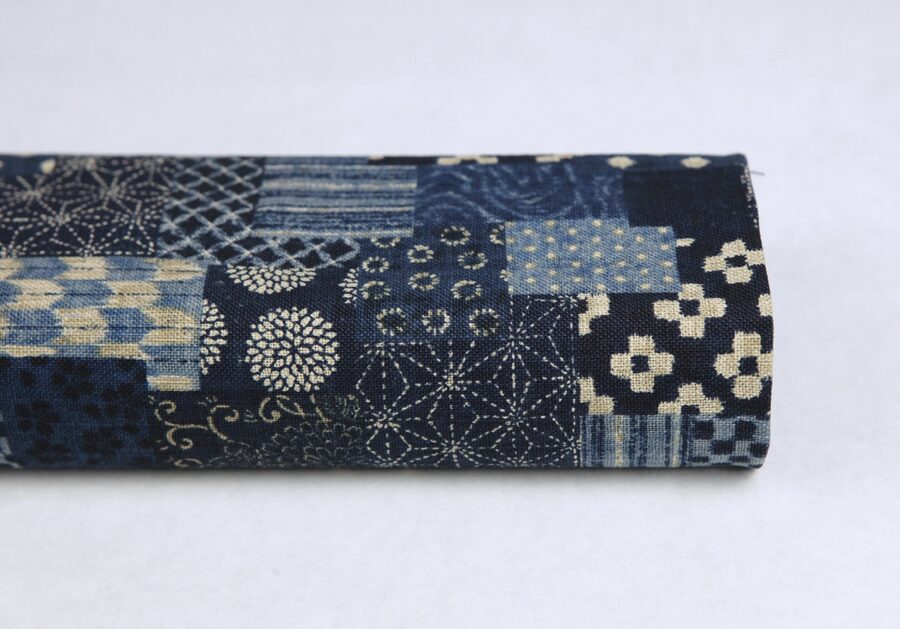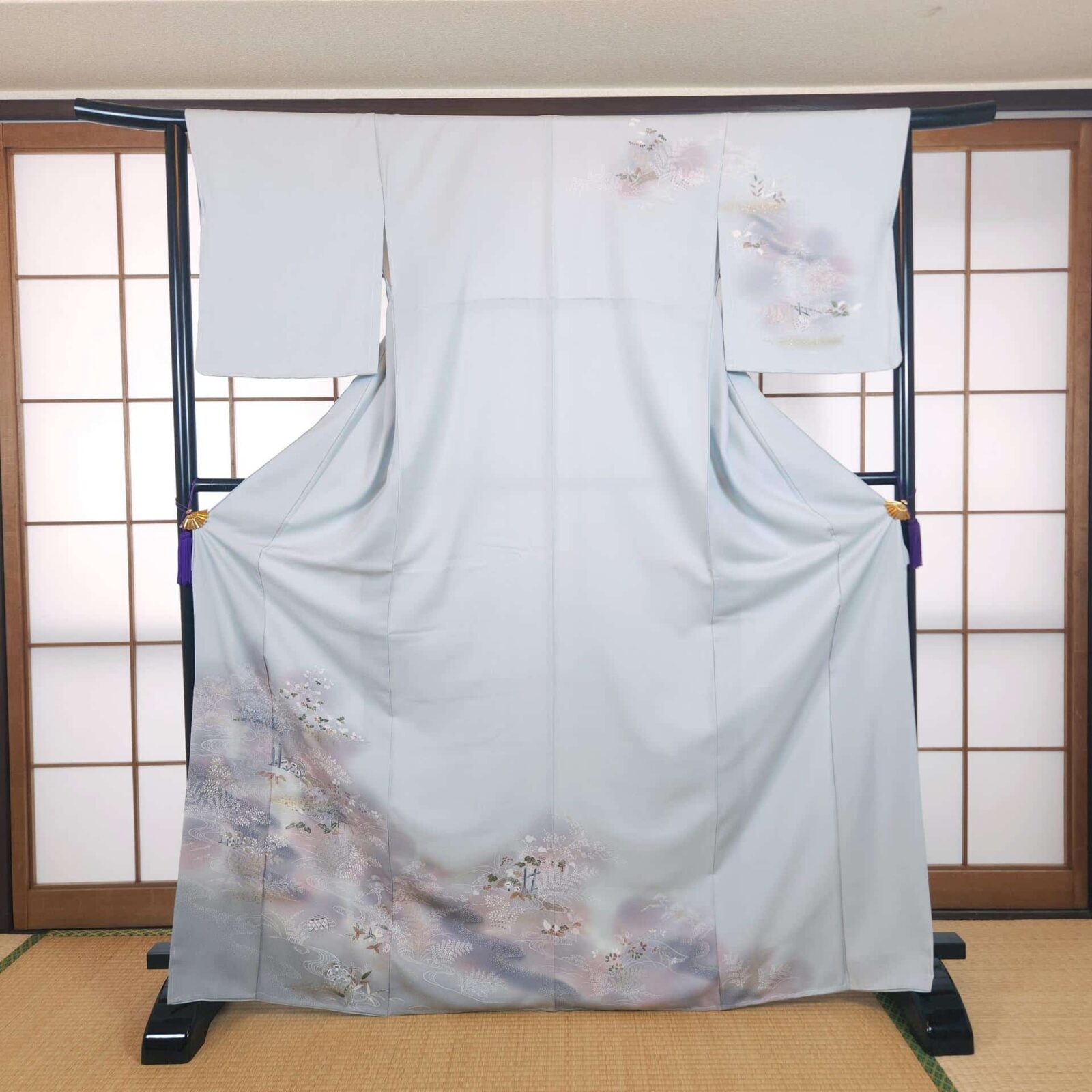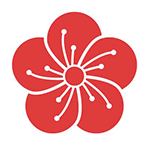Japanese fabrics are far more than simple materials. They represent a rich cultural heritage, steeped in history and exceptional craftsmanship. Featuring unique dyeing techniques, which we’ll explore further in this article, Japanese culture places significant value on fabric patterns and quality, often reflecting profound and symbolic values. Each piece of fabric tells its own story.
In this article, we’ll dive into these remarkable textiles, exploring some iconic patterns you may already recognize, as well as the artisanal techniques that have made them renowned worldwide—because there are so many to discover!
Prepare yourself to immerse in the captivating world of Japanese fabrics: their history, patterns, and craftsmanship!
1. The History of Japanese Fabrics
Early Origins and Ancient Techniques
The history of Japanese fabrics is nothing short of fascinating—rooted in an enduring legacy of ancient traditions that developed through the Yayoi, Kofun, Asuka, and Nara periods. Early weaving techniques date back centuries, heavily influenced by neighboring cultures such as China and Korea. These cultural exchanges allowed Japan to evolve its own distinct methods.
Hemp and Wild Silk: The Early Materials
Two key materials defined the early eras during the Yayoi and Kofun periods: hemp (asa – 麻) and wild silk (kinu – 絹).
- Hemp, known for its strength and durability, was widely used for everyday clothing and domestic textiles, playing a pivotal role in Japan’s rural economy. We’ll delve deeper into its applications later in the article.
- Wild silk, prized for its natural luster and softness, was reserved for creating elegant pieces worn by the upper classes. You can probably imagine the kinds of luxurious items it was used for.
Dyeing and Printing Techniques
During the Asuka and Nara periods, natural dyes like indigo (ai – 藍) introduced rich hues to fabrics. For example, the famed shibori (絞り) technique—tying and folding fabric before dyeing—emerged during this time. This method enabled artisans to experiment with innovative patterns, paving the way for diverse designs that continue to inspire contemporary creators. But more on that later!

The Introduction and Democratization of Cotton
In the 16th century, the introduction of cotton (momen – 木綿) marked a significant turning point. More accessible than silk, cotton democratized high-quality clothing for the common people.
- Increased accessibility: Cotton became a preferred choice for the working classes, offering a more affordable alternative to luxurious fabrics like hemp and wild silk.
- Emergence of new patterns: With cotton’s arrival, artisans began experimenting with new styles of clothing. Bold and colorful patterns emerged, reflecting social and cultural evolution.
- Influence of social hierarchy: While nobles continued to favor refined materials and traditional weaving techniques, cotton enabled artisans to craft pieces that showcased their skill and creativity, bringing artistry to a wider audience.

The Edo Period: A Golden Age for Textiles
During the Edo period (Edo jidai – 江戸時代), from 1603 to 1868, Japan experienced a time of political and economic stability. This era fostered the growth of urban culture and advancements in arts and crafts, including textiles.
Weaving and dyeing techniques saw significant advancements during this time. For instance, kasuri (絣), a method where threads are tied before dyeing to create simple, blurred patterns, became popular. Meanwhile, artisans in the Kyoto region perfected yuzen (友禅染), a hand-dyeing technique that allowed for the creation of colorful and detailed designs directly on silk.
By mastering these techniques and using high-quality materials, artisans crafted traditional Japanese patterns rich in symbolism and history. These motifs, deeply rooted in Japanese culture, continue to influence modern fashion today.
2. Influence of Natural Elements on Patterns
Nature has played a crucial role in the creation of Japanese textile patterns. Artisans drew inspiration from the surrounding landscapes, seasons, and local flora to bring their works to life. Among the most iconic motifs, which you’re probably familiar with, are:
- Asanoha (麻の葉): This hemp leaf-shaped pattern (not a star, as it might seem!) symbolizes strength and protection while evoking a deep connection to nature. Traditionally used in children’s clothing, Asanoha wishes for a strong and healthy life for the young. We’ll explore this further later on.
- Seigaiha (青海波): Representing stylized waves, this motif symbolizes tranquility and good fortune. It also reflects the passage of time and natural cycles, embodying harmony and the fluidity of life—a true philosophy!
- Sakura (桜): The famous cherry blossom is a powerful symbol of fleeting beauty and renewal, celebrating the spring season and the transient nature of life.
- Kiku (菊): The chrysanthemum represents longevity and perfection. Often associated with the imperial family, it is used in elegant motifs for special occasions. I’m particularly fond of this design—how about you?
- Tsuru (鶴): The magnificent Japanese crane symbolizes longevity, good fortune, and fidelity. This motif is commonly used in textiles for weddings and important ceremonies, symbolizing hope and prosperity. According to legend, folding a thousand origami cranes grants a wish—something I haven’t tried yet!
- Momiji (紅葉): Maple leaves embody autumn, transformation, and the fleeting beauty of nature. This motif is especially cherished during autumn festivals (momijigari) and appears in seasonal textiles celebrating nature’s changes and Japan’s scenic beauty.
- Kikko (亀甲): Inspired by the turtle’s shell, this pattern represents longevity and good fortune. In Japanese culture, turtles are sacred animals associated with wisdom and protection. This motif is often seen in ceremonial textiles and elegant kimonos. It is also popular in celebrations of longevity, such as Kanreki (還暦)—a traditional Japanese 60th birthday celebration marking the completion of a full zodiac cycle (12 years x 5), symbolizing renewal and rebirth.
- Tsubaki (椿): The camellia flower symbolizes modesty, purity, elegance, and feminine beauty. Used in textiles for formal occasions and ceremonial attire, Tsubaki reflects grace and sophistication, embodying the refined aesthetics of Japanese culture.
These patterns are far from mere decoration. They carry deep symbolic meanings, illustrating harmony between humanity and nature while reflecting Japanese philosophy and Shinto perspectives. From geometric designs to floral motifs, each detail speaks to Japan’s cultural identity and continues to inspire designers and artists worldwide.
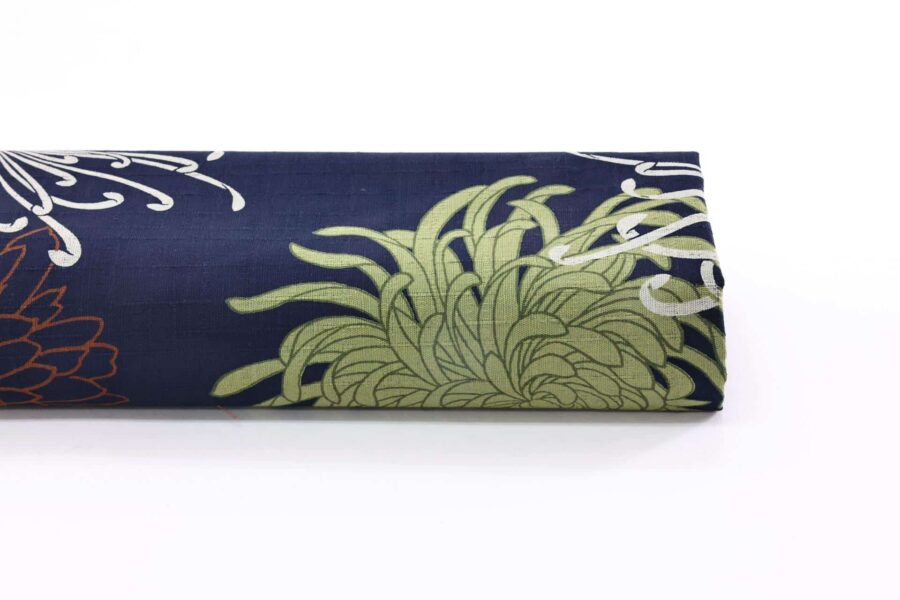
Japanese fabric Kiku in sparkle blue background
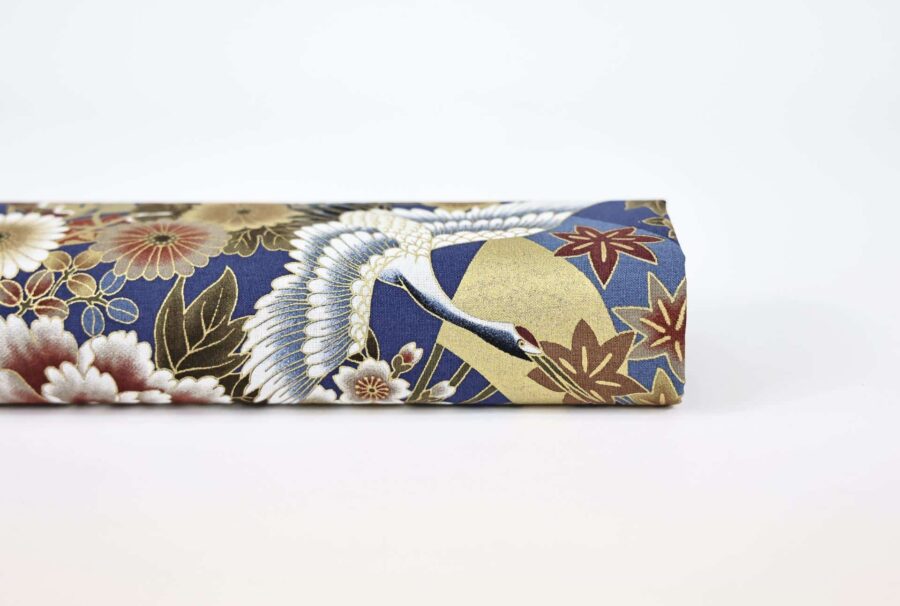
Japanese fabric Crane Hana Gosho Guruma blue background
3. Japanese Textile-Making Techniques
Japan is renowned for its unique textile techniques that seamlessly blend tradition and innovation. Two iconic methods, shibori and sashiko, perfectly exemplify this richness. Additionally, although kintsugi is primarily associated with ceramics, its philosophy resonates in Japanese textiles, symbolizing the beauty of imperfections.
Shibori: An Ancient Dyeing Technique
This traditional Japanese dyeing technique truly flourished during the Asuka (538–710) and Nara (710–794) periods in Japan. Originating in Tokushima on Shikoku Island, where it is still practiced today, shibori employs methods such as folding, tying, and compressing fabric to create intricate and varied patterns. Once the fabric is meticulously prepared, artisans immerse it in an indigo dye bath. This process, known as aizome (蒼染), gradually reveals the patterns, with each piece adorned in mesmerizing, distinctive shades. Every shibori (絞り) creation is therefore unique, reflecting ancestral craftsmanship passed down through generations.
Shibori also embodies an environmentally friendly approach, utilizing natural dyes and traditional methods of dyeing—great for the planet, wouldn’t you agree?
Over the centuries, shibori has evolved, incorporating modern influences while preserving its traditional essence. This enduring and innovative technique remains a vibrant part of Japan’s textile landscape.
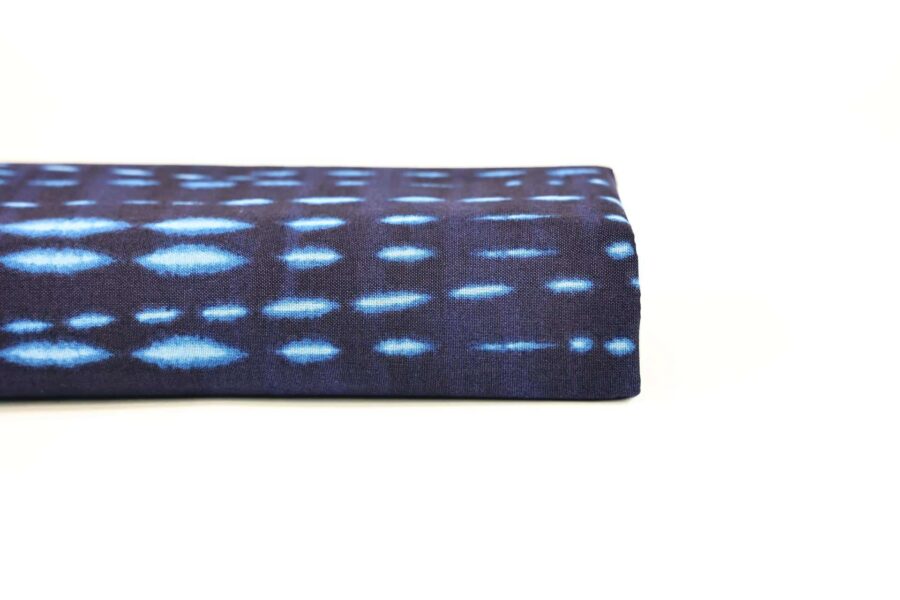
Japanese indigo fabric Shibori style stripe pattern
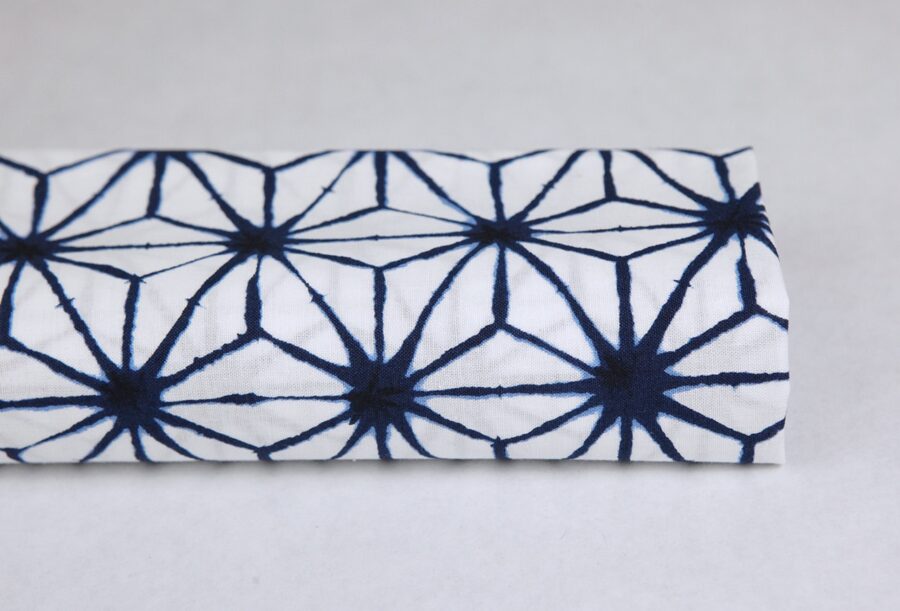
Asanoha Shibori indigo fabric white background 1M

Japanese fabric flower pattern in shibori style
Sashiko: The Art of Japanese Quilting
Sashiko (刺し子), meaning “little brushstrokes” or “little stabs,” is a decorative quilting technique that emerged during the Edo period (1603–1868) in rural regions of Japan, particularly in the Sendai prefecture. Initially, sashiko was used by farmers to reinforce their clothing and repair damaged fabrics. By employing contrasting threads, often in shades of blue, artisans created simple geometric patterns, such as the Asanoha motif mentioned earlier. These designs not only extended the life of the garments but also added an artistic touch.
For children, sashiko was often used to mend torn clothing, transforming worn-out pieces into unique works of art. This technique allowed families to preserve their garments while giving them a renewed aesthetic.
Today, sashiko is celebrated not only for its historical practicality but also for its decorative beauty. It has been incorporated into contemporary creations ranging from clothing to home décor accessories, and even patchwork inspired by the boro aesthetic. But that’s a story for another article!
Kintsugi: The Beauty of Imperfections
For those familiar with the term, you might point out that kintsugi isn’t a textile technique—and you’d be absolutely right! This method is best known for its use in repairing ceramics, where broken objects are restored with lacquer mixed with gold or silver powder, highlighting the cracks rather than concealing them. Emerging in the 15th century, kintsugi embodies a profound philosophy: celebrating imperfections and giving new life to objects, with each scar telling a unique story and transforming the flawed into something precious. It’s a beautiful concept, isn’t it?
In the textile world, this philosophy resonates deeply. It inspires repair and decorative techniques that elevate imperfections, highlighting the history of garments. For example, as we’ve discussed, some sashiko practices incorporate patterns that enhance repairs, turning each piece into a meaningful and aesthetically rich work of art. Textiles cease to be mere utilitarian objects and instead become mediums of artistic expression, embodying resilience and timeless beauty.
In conclusion! These practices perfectly illustrate the balance between functionality and aesthetics that defines Japanese culture, further enriching the country’s textile heritage.
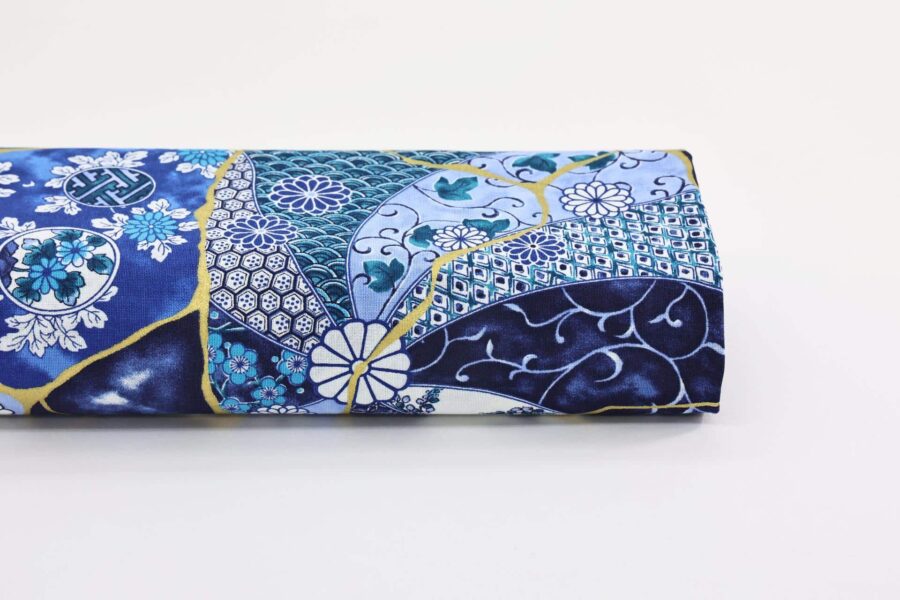
Japanese fabric Kintsugi inspired blue color 1M
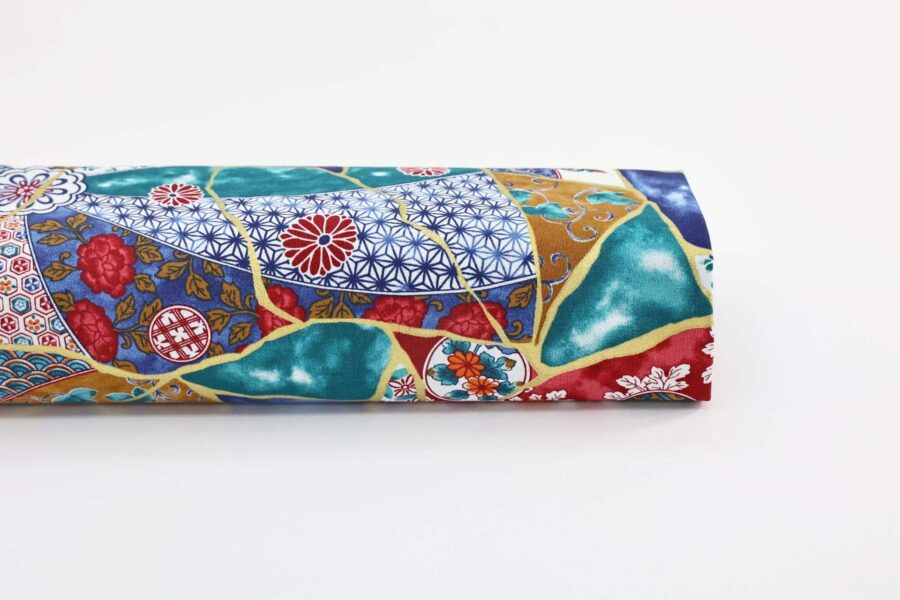
Japanese fabric Kintsugi inspired colorful
4. Contemporary Impact of Japanese Fabrics: Modern Designers and Fascinating Innovations
Japanese fabrics continue to captivate and inspire today’s creators, who skillfully blend centuries-old traditions with bold contemporary designs. Take Issey Miyake as an example—a visionary who masterfully combined ancestral techniques with modern technology through his iconic Pleats Please collection. By using polyester to create lightweight, flexible, and incredibly expressive garments, he redefined the way we perceive Japan’s textile heritage. Isn’t it fascinating to see how the past and future can meet to create such inspiring harmony?
But that’s not all! Today’s designers don’t just replicate traditional patterns like seigaiha; they reimagine them with daring creativity, giving these motifs a fresh and vibrant new life. Imagine a piece that merges the symbolic depth of this wave pattern with minimalist, modern lines—sometimes even playful touches. It’s a perfect example of honoring the past while reinventing it for the present.
Furthermore, the rise of ecological awareness plays a major role in this textile renaissance. Materials like hemp and wild silk, once ubiquitous, are making a strong comeback. These natural, durable, and timeless resources are becoming top choices for environmentally friendly creations. In this way, Japanese fabrics remain true to their roots while adapting to modern challenges.
This wonderful alchemy of tradition and innovation is proof of their enduring legacy.
5. A Living and Vibrant Cultural Heritage
Japanese fabrics are far more than mere materials—they breathe a rich and profound cultural soul. Every woven thread tells a story, and every pattern evokes centuries of traditions and carefully preserved creativity. Imagine a kimono: a true canvas of artistic expression, blending vibrant colors and refined textures, with each element carrying its own unique meaning. Japanese patterns aren’t just beautiful designs; they embody deep values of harmony, protection, and a profound connection to nature, as we’ve explored earlier.
And today? Their magic remains just as powerful. Whether in celebrations, official events, or even modern wardrobes, these fabrics continue to find their place everywhere. Designers, driven by a sincere respect for this heritage, constantly reimagine these cultural treasures, integrating them into unique and contemporary pieces. They weave a bridge between a rich past and a bold present, honoring tradition while adapting it to today’s trends.
The world of Japanese fabrics is a true living jewel, proof that a heritage can evolve without ever losing its essence.
6. A Bright Future Between Tradition and Modernity
En conclusion, les tissus japonais sont bien plus qu’un élément du passé : ils portent en eux la promesse d’un futur éblouissant. Imaginez un univers où la créativité moderne s’entrelace avec le respect profond des traditIn conclusion, Japanese fabrics are far more than relics of the past—they carry the promise of a dazzling future. Imagine a world where modern creativity intertwines with a deep respect for ancestral traditions. This is what lies ahead: passionate designers reinventing traditional patterns with bold touches, all while preserving their unique soul.
- A harmony between old and new: Iconic patterns find fresh life in contemporary designs that resonate across generations.
- A commitment to sustainability: By reintroducing ancient materials into responsible creations, artisans demonstrate that style can go hand in hand with respect for nature.
- A vibrant transmission: Through festivals, exhibitions, and international collaborations, this textile heritage continues to shine far beyond Japan’s borders.
What makes Japanese fabrics so captivating is their ability to tell a story that evolves over time. They embody a dialogue between eras, a melody of tradition and innovation. With every thread, every pattern, they remind us that authenticity and modernity can coexist to create something truly extraordinary.
The journey into the world of Japanese fabrics is far from over—it’s only just beginning.







